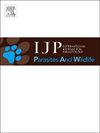Ehrlichia canis and Hepatozoon spp. in captive tigers in Thailand
IF 2
3区 医学
Q3 ECOLOGY
International Journal for Parasitology-Parasites and Wildlife
Pub Date : 2025-06-18
DOI:10.1016/j.ijppaw.2025.101105
引用次数: 0
Abstract
Captive wildlife can serve as reservoirs for various tick-borne pathogens for both domestic animals and humans. Ecotourism tiger parks, where tigers (Panthera tigris) engage with humans and other animals, increase the risk of disease transmission. This study aimed to investigate the infection rate, co-infection patterns, and associated risk factors of tick-borne pathogens (Ehrlichia, Hepatozoon, and Babesia) in captive tigers in Thailand. Blood samples were collected from 100 tigers and analyzed using multiplex PCR to detect the presence of three genera of tick-borne pathogens. The overall infection rate at least one tick-borne pathogen was 17 % (17/100). Ehrlichia canis was the most common, affecting 15 % (15/100) of the tigers, followed by Hepatozoon spp. [5 % (5/100)], with no detected Babesia spp. infection. Ehrlichia canis and Hepatozoon spp. co-infections were confirmed in 3 % (3/100) of the cases. Infection rates were examined according to sex and age. Female tigers exhibited a higher infection rate (22.22 % (10/45)) than males (12.73 % (7/55)), though this difference was not statistically significant (p = 0.209). Age was a significant factor, with older tigers showing higher infection rates (p < 0.001). Co-infections were observed in tigers older than seven years. All infected tigers, single or co-infected, commonly exhibited hyperproteinemia, anemia, and elevated creatinine levels in their blood. All pathogens identified in this study posed health risks to captive tigers, with infection rates primarily influenced by age. Ehrlichia canis poses the highest health risk for captive tigers in Thailand. These findings underscore the importance of routine health monitoring and effective tick control strategies to protect these endangered animals.
泰国圈养老虎的犬埃利希体和肝虫属
圈养野生动物可作为家畜和人类各种蜱传病原体的宿主。生态旅游虎园,在那里老虎(Panthera tigris)与人类和其他动物接触,增加疾病传播的风险。本研究旨在调查泰国圈养老虎蜱传病原体(埃利希体、肝虫和巴贝斯虫)的感染率、共感染模式和相关危险因素。采集了100只老虎的血液样本,采用多重聚合酶链反应对其进行分析,以检测蜱传病原体的三属。至少一种蜱传病原体的总感染率为17%(17/100)。最常见的是犬埃利希体,感染15%(15/100),其次是肝虫,感染5%(5/100),未检出巴贝斯虫感染。犬埃利希体和肝虫共感染3%(3/100)。按性别和年龄检查感染率。雌虎的感染率(22.22%(10/45))高于雄虎(12.73%(7/55)),但差异无统计学意义(p = 0.209)。年龄是重要因素,年龄较大的老虎感染率较高(p <;0.001)。在7岁以上的老虎中观察到合并感染。所有感染的老虎,无论是单独感染还是共同感染,通常表现为高蛋白血症、贫血和血液中肌酐水平升高。本研究确定的所有病原体都对圈养老虎构成健康风险,感染率主要受年龄影响。犬埃利希体对泰国圈养老虎的健康风险最高。这些发现强调了常规健康监测和有效蜱虫控制策略对保护这些濒危动物的重要性。
本文章由计算机程序翻译,如有差异,请以英文原文为准。
求助全文
约1分钟内获得全文
求助全文
来源期刊

International Journal for Parasitology-Parasites and Wildlife
Medicine-Infectious Diseases
CiteScore
3.80
自引率
5.60%
发文量
113
审稿时长
45 days
期刊介绍:
The International Journal for Parasitology: Parasites and Wildlife (IJP-PAW) publishes the results of original research on parasites of all wildlife, invertebrate and vertebrate. This includes free-ranging, wild populations, as well as captive wildlife, semi-domesticated species (e.g. reindeer) and farmed populations of recently domesticated or wild-captured species (e.g. cultured fishes). Articles on all aspects of wildlife parasitology are welcomed including taxonomy, biodiversity and distribution, ecology and epidemiology, population biology and host-parasite relationships. The impact of parasites on the health and conservation of wildlife is seen as an important area covered by the journal especially the potential role of environmental factors, for example climate. Also important to the journal is ''one health'' and the nature of interactions between wildlife, people and domestic animals, including disease emergence and zoonoses.
 求助内容:
求助内容: 应助结果提醒方式:
应助结果提醒方式:


